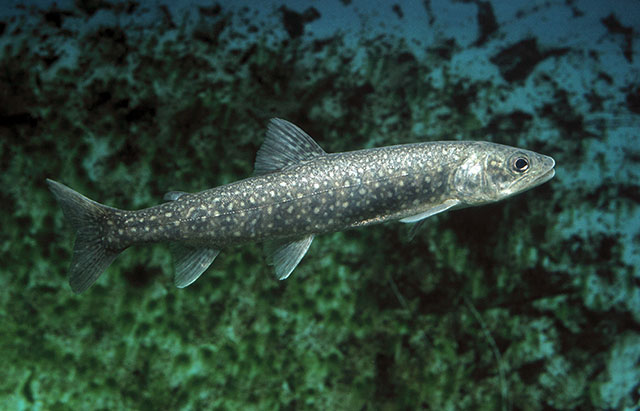| Salmonidae (Salmonids), subfamily: Salmoninae |
| 150 cm TL (male/unsexed); max.weight: 33 kg; max. reported age: 50 years |
|
benthopelagic; freshwater; depth range 3 - 61 m, non-migratory |
| North America: Atlantic, Arctic, and Pacific basins from northern Canada and Alaska south to New England in USA, Great Lakes, and northern Montana, USA. Introduced widely to many areas outside its native range.
Splakes (hybrid between Salvelinus namaycush and Salvelinus fontinalis) have also been successfully introduced to many areas of North America. The three observed phenotypes existing in Lake Superior (lean, siscowet and humper or paperbelly) are under some genetic control and not merely expressions of environmental adaptation (Ref. 40529). |
|
Dorsal spines (total): 4-5; Dorsal soft rays (total): 8-10; Anal spines: 4-5; Anal soft rays: 8-10; Vertebrae: 61-69. Distinguished by its color, white or yellowish spots on a dark green to grayish background, its deeply forked tail and its numerous pyloric caeca. Lateral line slightly curved anteriorly; pelvic fins with small axillary process (Ref. 27547). Body typically trout-like, elongate, somewhat rounded. Head stout, broad dorsally; mouth large, terminal, snout usually protruding slightly beyond lower jaw when mouth is closed. Back and sides usually dark green liberally sprinkled with whitish to yellowish (never pink or red) spots; overall color varies from light green to gray, brown, dark green or nearly black; belly white; pale spots present on dorsal, adipose and caudal fins and usually on base of anal; sometimes orange-red on paired fins, especially in northern populations; anterior edge of paired and anal fins sometimes with a white border. At spawning time, males develop a dark lateral stripe and become paler on the back (Ref. 27547). Caudal fin with 19 rays (Ref. 2196). Distinguished from congeners in Europe by the unique dark brown head, body, dorsal and caudal fins, covered by small pale spots; differs also by its deeply forked caudal fin (Ref. 59043). |
| Occurs in shallow and deep waters of northern lakes and streams and is restricted to relatively deep lakes in the southern part of its range (Ref. 5723, 86798). Rarely found in brackish water (Ref. 11980). A solitary wanderer, the extent of their movements apparently limited by the size of the lake and individual (Ref. 27547). Although lake trout generally feed on a variety of organisms such as freshwater sponges, crustaceans, insects, fishes (with a preference for ciscoes), and small mammals, some populations feed on plankton throughout their lives (Ref. 27547). Such plankton-feeding lake trout grow more slowly, mature earlier and at smaller size, die sooner and attain smaller maximum size than do their fish-eating counterparts (Ref. 30351). Lake trout are highly susceptible to pollution, especially from insecticides (Ref. 14019, 27547). Utilized as a food fish, its flesh is usually of a yellow or creamy color but may be anything from white to orange (Ref. 27547). Often caught by fishers (Ref. 30578). |
|
Not Evaluated (N.E.) Ref. (130435)
|
| harmless |
Source and more info: www.fishbase.org. For personal, classroom, and other internal use only. Not for publication.

